Hard to get fresh air
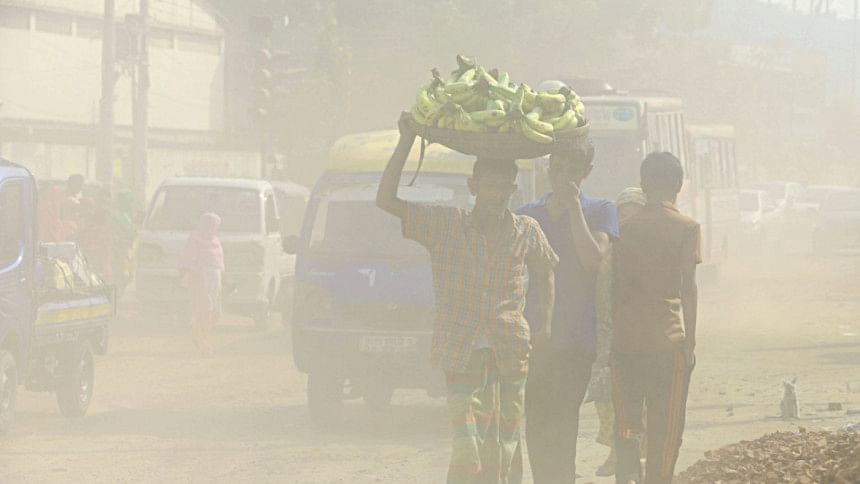
If you are in Dhaka city, think twice before drawing a deep breath.
The city’s air is contaminated with not only heavy metals like lead, chromium, cadmium, nickel, arsenic, manganese and copper but also with other poisonous particles, show studies.
The presence of pollutant particles in the air even on a normal day, except for those in the rainy season, is more than three to four times the desirable limit.
The level of air pollution in Dhaka is so alarming that the city is often ranked among the most polluted ones in the world. Against this backdrop, the country observes the World Environment Day tomorrow.
The level of pollutants is higher in the city than other parts of the country, and it gets worse with the advent of winter, said officials of the Department of Environment (DoE).
Brick kilns, faulty vehicles, dust from roads and construction sites, and toxic fumes from industries are the sources of air pollution.
Bangladesh National Ambient Air Quality Standard guidelines say the presence of particulate matters (PM) 10 in the air should remain within 150 microgram per cubic metre (mg/m3) within 24 hours and that of PM2.5 within 65 mg/m3.
In January this year, the average concentration level of PM10 was 104-401 mg/m3 and that of PM2.5 was 87-229 mg/m3 in the capital, according to the DoE, which measures the air quality under its Clean Air and Sustainable Environment (CASE) project.
The density of airborne particulate matter started decreasing in the following months.
In April, the average concentration level of PM10 was 49-222 mg/m3 and that of PM2.5 was 28-78 mg/m3 in the city.
“The level of air pollution round the year remains higher than the standard level. But it worsens during the dry season,” Ziaul Haque, director of Air Quality at the DoE, told The Daily Star.
Rain plays a great role in cleaning dust in the air. Since the volume of rainfall decreases in the winter, pollution level in the air goes up, he added.
Both particulate matters 10 and 2.5 cause serious health hazards. The PM10 is usually present in smoke from burning of wood and can go deep into the cardiovascular system.
The PM2.5 generally arises from burning of fossil fuels and has a strong association with circulatory diseases. Due to its tiny size, PM2.5 can penetrate deep into the human respiratory system, causing a wide range of short and long-term health effects.
Indoor and outdoor air pollution led to 1.23 lakh deaths in Bangladesh in 2017, according to the State of Global Air 2019 report published recently by US-based organisation Health Effects Institute and Institute for Health Metrics and Evaluation.
It said air pollution was the fifth highest mortality risk factor globally.
Experts say these particulate matters may cause bronchial and kidney diseases and even lung cancer. A significant number of city dwellers suffer from respiratory diseases and asthma in the winter every year.
According to the DoE and the World Bank, brick kilns are responsible for 56 percent of air pollution in the country.
The government enacted a law last year to make these kilns environment-friendly, but a recent report indicated that of the 7,772 brick kilns across the country, 2,123 are yet to adopt the required modern and environment-friendly technology.
“The major sources of outdoor air pollution in Bangladesh are brick kilns and development activities, especially construction work,” said Ziaul.
A group of researchers led by Prof Abdus Salam of Dhaka University’s Chemistry department carried out a study on air pollution in different parts of the city early this year.
For the study, markets and streets were chosen in five areas of the city -- Uttara, Mirpur, Chawkbazar, Badda and Malibagh.
It was found that both indoor and outdoor pollution in those five places are almost the same and the level of air pollution was three to five times the limit set by the World Health Organisation.
During the same period, the group carried out another study at six locations to determine the health risks of air pollution.
The locations are Teacher-Student Centre (TSC) of Dhaka University, a construction site in Bashundhara, traffic intersection point at Bijoy Sarani, a food factory in Baridhara, a residential block in Banani, and Gulshan Park.
The study found that the level of air pollution was higher in the morning than that at any other time of the day as a large number of vehicles ply the roads at that time.
Vehicle emission and construction work as well as industrial emission contribute mostly to particulate pollution at the TSC, Kuratoli, Bijoy Sarani, Baridhara, Banani and Gulshan, it said.
WAY OUT
“First of all, we have to control the source [of air pollution],” said Prof Salam.
Since construction sites are one of the major sources, it should be well managed. Besides, open burning of garbage should be stopped and traffic has to be controlled, he said.
Salam suggested using high quality fossil fuel, planting more trees and having more waterbodies in the city.
Ziaul said the government has taken various measures to reduce air pollution. It also amended the brick kiln act to encourage use of blocks.
“We have drafted the clean air act which will allow us to take steps to check air pollution at construction sites.”
On faulty vehicles, the DoE official said they have already written to the authorities concerned to prevent vehicles aged above 20 years from plying the roads.
“We also wrote to cement and iron rolling factories to take steps to reduce air pollution,” Ziaul said.


 For all latest news, follow The Daily Star's Google News channel.
For all latest news, follow The Daily Star's Google News channel. 


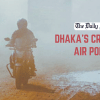
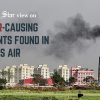

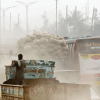

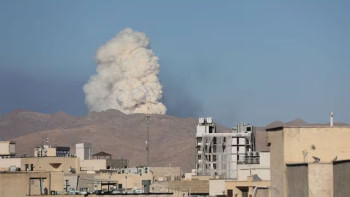
Comments